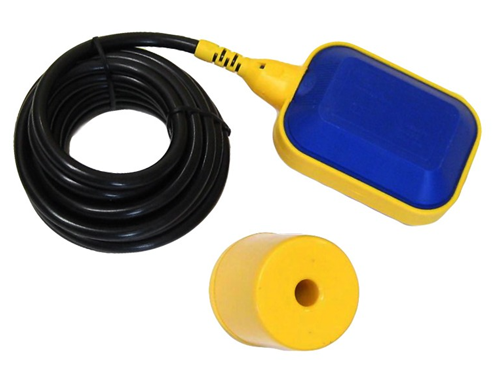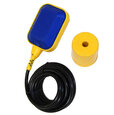Sump Pump Float Switch Working Principle
Figure 1: Float switch for sump pump
A sump pump float switch is a level-sensing device that controls the operation of a sump pump. It safeguards against water accumulation in basements or other low-lying areas by activating the pump when water reaches a predetermined level and deactivating it when the water subsides. Proper float switch selection and installation are crucial for preventing water damage and ensuring reliable sump pump operation. In this article you will learn how a sump pump float switch works, the different float switch types, and their main selection criteria.
Table of contents
- Sump pump float switch working principle
- Sump pump float switch types
- Float switch construction
- Sump pump float switch selection parameters
- FAQs
View our online selection of float switches!
Sump pump float switch working principle
A sump pump float switch detects flooding in the basement tank. The switch floats on the water's surface or within the water and moves according to the water level within the tank. When the water level rises, the float switch rises with it. When the water level rises high enough, the switch within the float closes and switches on the sump pump that discharges the tank. When the water level drops sufficiently low, the switch inside the float opens and stops the pump - this cycle repeats. Read our article on float switches for more details on the working and various types of float switches.
Sump pump float switch types
Pump-up float switch
Pump-up float switches (normally closed) work with sump pumps that fill a storage tank. A pump-up float switch is at the top of the storage tank. As the water level increases, the float switch rises within the tank. The switch inside the float opens, turning the pump off and preventing further filling of the storage tank. The power for the sump pump first routes to the float switch at the top of the tank and then to the pump that fills the storage tank.
Pump-down float switch
Pump-down float switches (normally open) work with pumps that empty a tank. The float switch shuts off the pump before it runs out of water entirely and starts sucking air. The pump can lose its prime by sucking air, shortening its lifespan. Pump-down float switches are approximately 101 mm - 152 mm (4 - 6 inches) above the pump suction. The switch inside the float closes when the water level increases. The closed connection within the switch supplies power to the pump. The pump turns on and removes the water from the tank. As the water level drops, the switch inside the float switch falls down, the internal switch will open, and the pump will turn off.
Float switch construction
A tethered float switch is commonly used with sump pumps. It has a floating element that lowers and rises with the water level in the sump basin. The switch creates a closed circuit that triggers the pump when the level exceeds a preset height. The switch mechanism comprises a floating hollow body with a steel ball inside. The floating element attaches to the pump with a cord. When the float pivots, the internal ball moves due to gravity and operates an electrical switch. Changing the cord length determines the level range of the switch.
The main drawback of tethered switches is that they require a large basin to move up and down. The longer the cord, the larger the risk that the float tangles on things inside the basin. Read our article on float switch wiring for more information on how to wire float switches.

Figure 2: Tethered float switch and counterweight
Sump pump float switch selection parameters
Apart from knowing whether the float switch should act in a normally open or normally closed position, there are several other considerations when selecting a suitable float switch for a sump pump.
Cable length
The length of the float switch's cable controls how high or low the water levels can be. The free cable between the weight (which keeps the switch in place) and the switch sets the maximum and minimum water levels. A longer cable allows for a greater range of control, making it suitable for deeper tanks or reservoirs. Connecting multiple cords to create an electrical connection within a wet environment can pose serious safety issues. Ensure to get a float switch with enough cord length. Cable lengths ranging from 2 to 10 meters are commonly available.
Maximum contact voltage and load
Check the float switch’s rating and ensure it matches the sump pump’s horsepower rating. Using a float switch on a sump power with a higher rating can shorten the lifespan of the switch. It's also crucial to match the maximum contact voltage and load current.
- Maximum contact voltage: This indicates the highest voltage the switch can safely operate with. Users should ensure that the voltage of their system does not exceed this limit to avoid damaging the switch or causing electrical hazards. For example a 250V float switch is suitable for residential and light commercial applications where the system voltage is typically around 230V or lower. A 400V float switch is ideal for industrial or heavy-duty applications where higher voltages are common, providing an extra safety margin and greater versatility.
- Maximum contact load: This specifies the maximum current the switch can handle. Users need to ensure that the current drawn by the connected pump does not exceed this limit to prevent overheating or failure of the switch.
Sump pump connector
Different voltages and countries have different connector styles, so it is necessary to verify that the connector for the float switch has the same style as the pump. A piggyback float switch connects the float switch’s plug to a standard power outlet. A piggyback plug has prongs on one side and an additional outlet on the other. A piggyback connector allows the user to unplug the cords from the wall, separate them, and plug the pump directly into the outlet without the switch, thereby allowing it to test the pump by itself.
Figure 3: Piggy back plug for MAC 3 floats witch
Pressure and temperature
Ensure the float switch can handle the system's pressure and temperature. For residential and clean water use, standard ratings are usually enough. For industrial or hot liquids, choose switches with higher ratings. A float switch with a maximum temperature of 50 °C and pressure of 1-2 bars is ideal for residential sump pumps, clean water systems, light industrial use, rainwater harvesting, and aquaculture.
Environment and type of media
When choosing a float switch for sump pumps, consider the specific environment and type of media it will encounter:
- Clean water: For residential sump pits or rainwater systems, select a float switch designed for clean water. These are suitable for less aggressive environments.
- Sewage and wastewater: For sump pumps handling sewage or contaminated water, choose a robust float switch that can manage contaminants and solids, ideal for septic systems and sewage pits.
- Industrial applications: In industrial settings, opt for a float switch built to withstand higher pressures, temperatures, and potentially corrosive environments, suitable for industrial sump pits and heavy-duty applications.
Maximum immersion depth
The maximum immersion depth of a float switch indicates how deep it can be submerged and still work properly. For instance, a float switch with a 10-meter (394-inch) maximum immersion depth can be used in applications up to 10 meters deep. Ensure the switch's maximum immersion depth is greater than the depth of your tank, pit, or reservoir. For example, a 10-meter immersion depth is suitable for an 8-meter deep sump pit. Always consider a safety margin for water level changes and installation depth.
Wide or narrow angle float switch
Narrow-angle float switches can cause the pump to turn on or off, even with minor changes in water level, like ripples. Turning the pump on and off rapidly can damage and shorten its operating life. For a wide-angle float switch, the water level needs to change by several inches to cause the float switch to either turn on or off. For example, a float switch that switches at an angle of 45 degrees is considered a wide-angle float switch. This type of switch requires a significant change in water level, typically several inches, to activate or deactivate. This design helps prevent the pump from turning on and off rapidly due to minor fluctuations in water level, such as ripples.
Degree of protection
A float switch with a high degree of protection, such as IP68, is ideal for environments where it may be fully submerged in water, ensuring reliable operation. For environments with explosive risks, select an explosion-proof float switch to ensure safe operation. These switches are designed to prevent ignition in hazardous areas, making them suitable for specific industrial and chemical applications.
Read our article on float switch replacement for more details on troubleshooting, fixing, and replacing a sump pump float switch.
FAQs
Does a sump pump need a float switch?
Yes, the float switch ensures that the sump pump turns on and drains the water out of the sump pit. The float switch can also be wired to fill the sump pit when the water level goes low.
How high should I set my sump pump float?
Hang the float switch a few inches above the top of the sump pump motor. The exact height varies depending on the sump pit size and the motor's power.
How do I know if my sump pump float switch is bad?
Check if the sump pump activates when the water level rises. If it doesn't, manually lift the float. If the pump still doesn't start, the float switch may be faulty and needs replacement.





